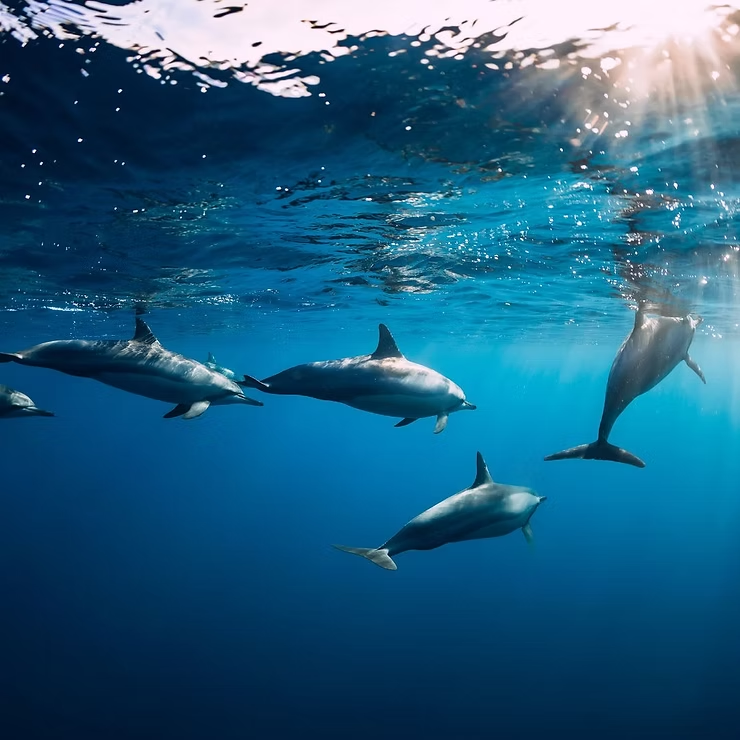Introduction
Dolphins are among the most captivating creatures of the sea, admired for their intelligence, playful nature, and complex social lives. This article explores the hidden world of dolphins, from their intricate societies and problem-solving skills to the myths and cultural stories that surround them. We also examine how they compare with other marine mammals, trace their life cycle, and highlight why conservation is vital for ensuring their survival.
Key Takeaways
- Dolphins form intricate societies with pods, alliances, and occasional solitary individuals.
- Their intelligence is displayed through tool use, problem-solving, and sophisticated communication.
- Common myths about dolphins often misrepresent their natural behaviors.
- Dolphins demonstrate higher cognitive abilities than many other marine mammals.
- Human activities, from overfishing to pollution, significantly impact dolphin habitats.
Dolphin Societies: More Than Just a Pod
The Structure of Dolphin Groups
Pods are the heart of dolphin society, ranging from a few to hundreds of members. These groups may consist of core families, allied males that form long-term partnerships, and associates who join temporarily. Such bonds help with hunting, protection, and survival in the open ocean.
Solitary Dolphins: Anomaly or Insight?
Not all dolphins live in pods. Some individuals live alone due to injury, separation, or unique behavior. These solitary dolphins challenge our assumptions and provide important insights into the flexibility of dolphin social dynamics.
How Dolphins Forge Relationships
- Play: Essential for learning and bonding among calves and adults.
- Cooperation: Coordinated hunting and defense strengthen group survival.
- Touch: Physical contact reinforces emotional connections.
Brainy in the Briny: Dolphin Intelligence
Cognitive Skills and Learning
Dolphins learn through observation, imitation, and experience. They use tools like sea sponges to protect their snouts and teach such skills across generations. This cultural transmission reflects advanced intelligence rarely found in marine life.
Problem-Solving Abilities
Dolphins devise hunting strategies, coordinate group efforts, and adapt quickly to challenges. Their ability to use debris as tools or herd fish highlights their creativity and adaptability.
The Dolphin Language
- Echolocation clicks for hunting and navigation.
- Whistles and burst-pulsed sounds for social interaction.
- Body movements to express emotions or intentions.
Myths and Misconceptions
Dolphins Rescuing Humans
Stories of dolphins saving humans are legendary. While some may reflect genuine protective instincts, many remain anecdotal. Their intelligence and curiosity likely explain these encounters.
The Myth of the Dolphin Smile
The “smile” is simply facial structure, not an expression of emotion. True dolphin feelings are revealed through behavior, vocalizations, and interactions.
Cultural Superstitions
Across cultures, dolphins symbolize luck, guidance, and protection. From ancient Greece to Pacific islands, they have inspired myths that reflect humanity’s reverence for these animals.
Comparing Marine Mammal Minds
Dolphins often outshine beluga whales and rival dogs in intelligence. Their communication, tool use, and social complexity place them among the most cognitively advanced animals in the ocean.
Habitats and Human Impact
Adaptations Across Environments
- Tropical waters: Abundant food and warm temperatures for raising young.
- Cooler seas: Blubber, echolocation, and dietary flexibility help survival.
Human Threats
- Overfishing depletes prey species.
- Pollution, plastics, and noise disrupt dolphin health and communication.
- Coastal development destroys critical habitats.
Life Cycle of Dolphins
Calves remain close to mothers for survival and learning. Social play and imitation prepare them for adulthood. Females reach maturity between 5 and 10 years, while males mature later, ensuring strong genetics and pod continuity. Elders pass down knowledge, guiding pods through challenges and maintaining traditions.
Diet and Feeding
- Fish: The main staple.
- Squid: A common favorite for many species.
- Crabs: An occasional opportunistic meal.
Feeding is often cooperative, reinforcing bonds within pods and teaching calves essential survival skills.
Playful or Purposeful Behavior
Dolphin play is more than fun—it builds skills, strengthens social ties, and supports hunting strategies. Leaping, splashing, or rubbing against surfaces may serve communication, hygiene, or food-gathering purposes.
Conservation Efforts
Threats to Survival
Dolphins face bycatch, pollution, and noise interference that threaten both physical health and social stability.
Success Stories
Conservation programs in Pakistan and New Zealand have helped dolphin populations recover through marine sanctuaries, education, and fishing regulation.
How You Can Help
- Choose sustainable seafood.
- Participate in beach clean-ups.
- Support marine protected areas.
- Educate others about dolphin conservation.
Cultural and Personal Stories
Folklore, hero tales, and personal encounters reveal the deep bond between dolphins and humans. From ancient myths to modern-day rescue stories, dolphins continue to inspire awe and connection.
Conclusion
Dolphins are more than playful swimmers—they are intelligent, social, and emotionally complex beings. Their survival depends on healthy oceans and our commitment to conservation. By protecting dolphins, we also safeguard the balance of marine ecosystems and preserve one of nature’s most remarkable species for generations to come.

